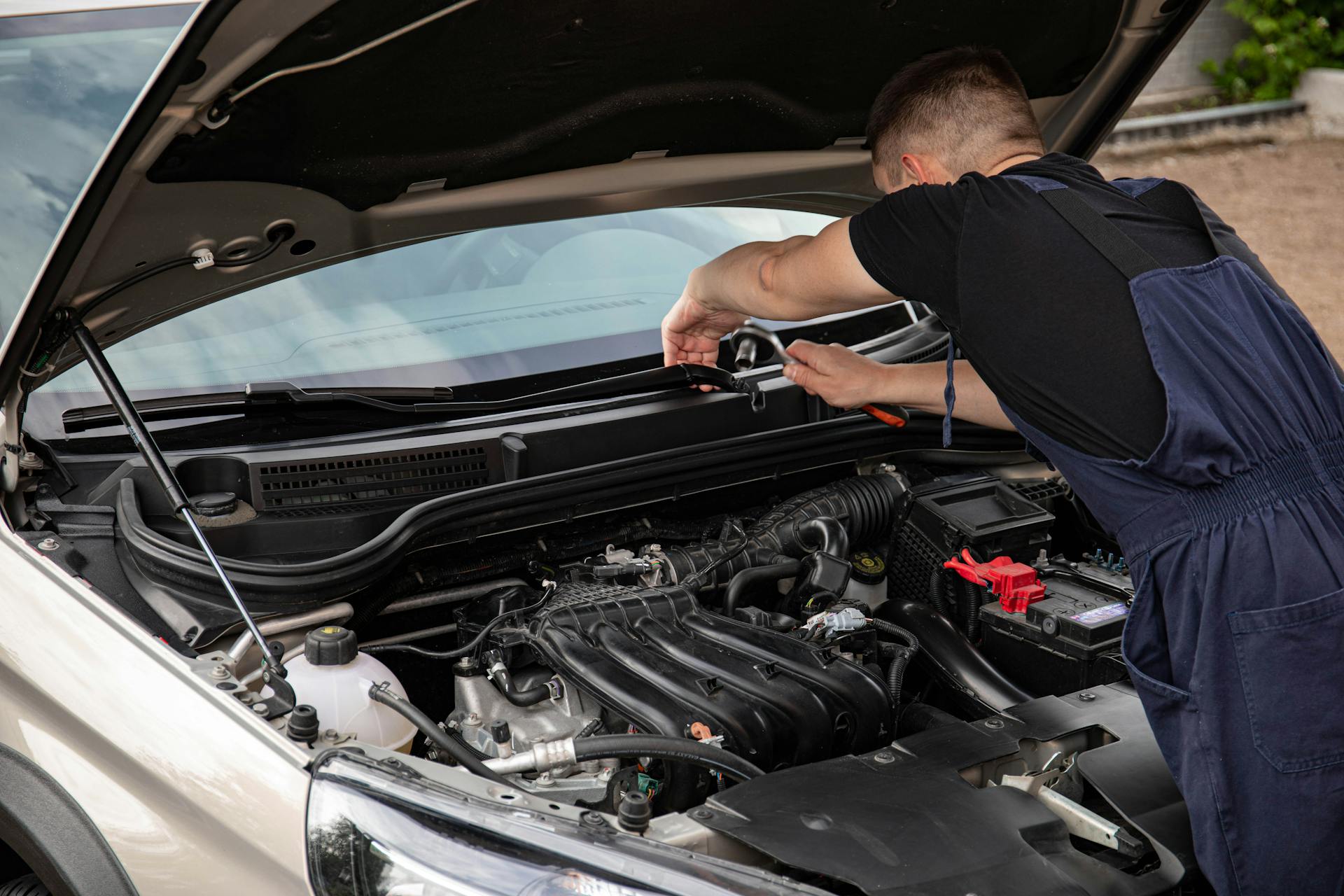
Car leasing can be a great way to drive a new car without the long-term commitment of ownership. However, it's not without its issues.
One common problem is mileage restrictions. Many lease agreements come with mileage limits, and excessive mileage can result in costly penalties. For example, a lease agreement might limit you to 12,000 miles per year, with a penalty of 15 cents per mile for each mile driven above that limit.
To avoid mileage penalties, it's essential to understand your lease agreement and plan your driving accordingly. If you know you drive a lot for work or pleasure, consider a lease with a higher mileage limit or factor the penalties into your budget.
Excessive wear and tear can also lead to costly fees when returning a leased car. This can include everything from minor scratches to major dents.
See what others are reading: Ford Class B Shares
Leasing Essentials
Leasing a car can be a great option, but it's essential to understand the basics to avoid any issues. Familiarize yourself with the terms used in leasing agreements, such as MSRP, which is the manufacturer's suggested retail price and is not negotiable.
See what others are reading: Leasing Foundation
Here are some key leasing terms to know:
- MSRP: The manufacturer's suggested retail price, which is not negotiable.
- Capitalized cost: The sale price of the car, which is negotiable.
- Drive-off fees: Payments you make upfront, such as the down payment (if there is one) and sales tax.
- Residual value: The car's expected value at the end of the lease term.
- Buyout price: The price you pay if you decide to buy the car at the end of the lease.
- Money factor: A representation of the interest rate, which you can multiply by 2,400 to see the equivalent annual percentage rate (APR).
- Acquisition fee: The administrative costs associated with processing the lease.
Your credit score also plays a significant role in leasing a car, as it can impact whether you'll be approved and the terms you receive. Generally, people with good to excellent credit qualify for a lease and get the best terms.
You might enjoy: Can I Lease a Car with 500 Credit Score
Regular Maintenance Matters
Regular maintenance is crucial when leasing a car. It can save you from extra charges at the end of the lease.
Leases allow for normal wear and tear, but things like cracked windows, large dents or torn upholstery may result in extra charges. The dealer will inspect your car for any damage before the lease is up.
To avoid extra charges, keep up with regular maintenance, like oil changes. This will help prevent costly repairs down the line.
Check your lease agreement for the dealer's definitions of "normal" and "excessive" wear and tear. This will give you a clear understanding of what's expected of you.
Here's a quick rundown of what you should do to maintain your leased car:
Buy the Car
You can buy the leased car when your lease ends, and it's a good option if you drive a lot. Most leases cap mileage, and going over the limit can cost you 10 to 30 cents per mile.
Leased cars also have to be returned in good condition, so if you have a messy pet or tend to attract dents, buying the car makes more sense. You'll avoid potential charges for excessive wear and tear.
If you plan to keep the car for a long time, buying is a better choice. You'll have no monthly payments after it's paid off, and the car will still have resale value. By contrast, you're left with nothing when a lease is up.
You can pay for the car with cash or finance it with an auto loan. To know the pre-determined sale price, look for the "residual value" in the lease paperwork.
Explore further: How to Buy Car after Lease
Returning a Leased Car
Returning a leased car can be a daunting task, but it doesn't have to be. Here's the lowdown on what you need to do.
You'll likely receive reminders from the leasing company as your lease expiration date approaches, so keep an eye out for those. Sometimes, they might even arrange for a flatbed truck to pick up your vehicle.
To prepare for the return, gather all the original lease paperwork and any other documents that came with the car, such as both sets of keys or key fobs. Check the glove box for the owner's manual and make sure the spare tire and jack are secure.
Excess mileage can be a costly penalty, so estimate the penalty for any overage before returning the car. This will help you avoid an unpleasant surprise.
Cleaning the vehicle, inside and out, is also a good idea. A thorough inspection will be conducted to identify wear and tear, and if it looks like you've taken good care of the car, the technician might show some leniency.
Here are some additional things to keep in mind:
- Your wallet will be needed at the time of return, as there may be money due.
- Keeping the car clean and up-to-date with basic maintenance tasks will help with the wear-and-tear inspection.
Lease Considerations
Leasing a car can be a great option, but it's essential to consider the details to avoid costly mistakes. Don't lease a car that extends beyond the factory warranty, as this protection is a significant benefit of leasing.
To set yourself up for success, read the fine print in your lease agreement carefully. This includes the lease term, monthly payment amount, money factor, capitalized cost, residual value, mileage included, fees, taxes, penalties for terminating the lease early, down payment amount, and buyout option details.
Be aware of the fees associated with your lease, including those for returning the car with nearly new tires. Make sure the policies and fees are clear and fair. You can also buy extra miles up front if you expect to run over the standard allotment, which can save you money in the long run.
Here are some key details to look out for in your lease agreement:
- Lease term
- Monthly payment amount
- Money factor
- Capitalized cost
- Residual value
- Mileage included in the lease
- Fees and when they may apply
- Taxes you're paying on the car
- Penalties for terminating the lease early
- Down payment amount
- Details of your buyout option
- Whether the lease includes upgrades, such as extended warranties and key replacement coverage
Negotiation and Awareness
Negotiating your car lease can be a daunting task, but it's essential to get the best deal possible. Dealerships may be willing to negotiate details such as mileage limit, lease period, buyout price, and down payment amount.
To start, know that negotiating the price of the vehicle is key, and only after you have a firm price should you bring up leasing. The more you put down, the less your finance charges will be.
You can also negotiate the lease money factor, the number used by some lessors to determine the interest portion of the monthly payment. This can help lower your monthly payments.
To keep your monthly payments as low as possible, look for cars that don't depreciate faster than average. Consumer Reports' owner-cost ratings can help you make an informed decision.
Here are some details that can be negotiated:
- Mileage limit
- Lease period
- Buyout price
- Lower money factor
- Down payment amount
- Trade-in value
Shopping around and getting quotes from various lease companies is also a good idea. This can help you compare offers and negotiate with the dealership to get the best deal.
Do Negotiate
Negotiating a car lease can save you a significant amount of money. By understanding the factors that affect your monthly payment, you can make informed decisions and get a better deal.
The car dealer calculates your monthly lease payment based on the car's capitalized cost minus its residual value. You pay the difference between those numbers, but negotiating can lower your costs. For example, if you want to lease a car with a capitalized cost of $25,000 and a residual value of $15,000, the difference is $10,000.
Negotiating a higher residual value and a lower car price will help you save money. Dealerships may also be willing to negotiate other details, such as mileage limit, lease period, buyout price, lower money factor, down payment amount, and trade-in value.
These details can be negotiated during certain times of the year, such as when dealerships are motivated to clear their inventory before a new car model arrives or at the end of the year.
To give you a better idea of what you can negotiate, here are some key points to consider:
- Mileage limit
- Lease period
- Buyout price
- Lower money factor
- Down payment amount
- Trade-in value
By understanding these factors and being aware of your negotiating power, you can get a better deal on your car lease.
Walk Away
Returning a leased car after the last payment is a straightforward process, but it's essential to settle any related fees first.
You are no longer responsible for the vehicle once the lease terminates, so you can't use it anymore.
The lease agreement typically outlines the terms for returning the car, including any fees or penalties for early termination.
This is a crucial step to avoid any potential issues or financial liabilities.
You can simply return the car and walk away, without any further obligations.
Check this out: Car Lease Fees to Avoid
Awareness
To keep your monthly payments as low as possible, look for cars that don't depreciate faster than average. Consumer Reports' owner-cost ratings are included in the model pages with detailed information on depreciation and other factors.
Depreciation can be a major factor in the overall cost of car ownership.
Cars that depreciate slower will generally have lower monthly payments.
Curious to learn more? Check out: Do Car Dealerships Lease Used Cars
Frequently Asked Questions
What is the 1% rule when leasing a car?
The 1% rule is a leasing guideline that calculates a good lease deal by dividing the monthly payment (excluding taxes) by the Manufacturer's Suggested Retail Price (MSRP), aiming for a result of 1% or lower. This rule helps determine a fair lease price for a 36-month lease with 12,000 miles.
Who pays for repairs on a leased car?
Lessees are typically responsible for paying for vehicle maintenance and repairs on a leased car. Learn more about your financial responsibilities and affordable repair options.
Sources
- https://www.kbb.com/car-advice/returning-a-lease-vehicle/
- https://www.consumerreports.org/money/car-financing/should-you-lease-your-next-car-a3342848831/
- https://www.bankrate.com/loans/auto-loans/leasing-traps-to-avoid/
- https://www.experian.com/blogs/ask-experian/dos-and-donts-of-leasing-car/
- https://www.consumerreports.org/money/car-financing/money-saving-tips-for-leasing-a-car-a1089995228/
Featured Images: pexels.com


